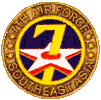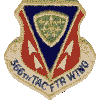| |
|
|
|
James Alan Crew
Major
389TH TAC FTR SQDN, 366TH TAC FTR WING, 7TH AF United States Air Force Windber, Pennsylvania May 15, 1941 to December 04, 1978 (Incident Date November 10, 1967) JAMES A CREW is on the Wall at Panel 29E, Line 66 See the full profile or name rubbing for James Crew |
   |
  |
|
29 May 2003 On 9 November 1967 a 480th Tac Ftr Sqdn F-4C (tail number 64-0751) crewed by Lt. Colonel John Armstrong and Lt. Lance Sijan went down near Ban Loboy Ford, Laos, as they bombed enemy supply routes. The circumstances indicated that the destruction of the aircraft could have happened in one of two ways: they could have taken a direct hit or the plane could have been blown up by its own bombs. Since Armstrong's flight was armed with the new FMU-35 time-delay fuzes, there was a distinct possibility that they had malfunctioned. Faulty fuzes could have prematurely triggered detonation of all six bombs, and if this had happened, over two tons of high explosive would have erupted less than fifty feet from the airplane. The next day, 10 Nov 1967, Lt. Colonel Kelly Cook told his wife in a letter that part of his flight assignment that night was to check out some malfunctioning bomb fuzes. Cook's flight that night consisted of two aircraft from the 389th Tac Ftr Sqdn:
When mechanically-fuzed bombs were released, the arming wire was pulled and a front spinner propeller began to spin. After the spinner rotated a certain number of revolutions -- set during ground weapons load -- the bomb's fuze was active and ready to detonate upon ground impact. The new FMU-35s, chemical fuzes developed for use on mines and delayed bombs, armed the bomb through a precisely-timed, two-step process: First, the bomb was released from the aircraft; this act pulled an arming wire, which then allowed the second step to begin. During the second step, chemicals began eating through a thin metal shield. When the shield was broached, the bomb was an armed mine: volatile and very sensitive to impact. Unfortunately, as they were to prove months later, there was a defect in the fuzes when the military first began using them, and, essentially, the bombs were arming when they were attached to the aircraft. This meant the bombs were live and deadly when released from the aircraft, allowing premature, sometimes immediate, detonation. Colonel Frederick "Boots" Blesse, Deputy Commander of Operations for the wing, suspected the fuzes were defective after the back-to-back losses of Armstrong/Sijan and Baffle Flight. At that time, he ordered all the FMU-35 fuzes removed and replaced with regular mechanical fuzes. Unfortunately, 7th Air Force didn't agree with Colonel Blesse's conclusion that the FMU-35 fuzes were at fault and he was ordered to continue using the FMU-35s. On 26 November 1967, Colonel Herbert O. Brennan and Lt. Douglas Condit went down in Laos (F-4C 64-0697, 390th TFS). It seemed to be a repeat performance of the Armstrong/Sijan loss two weeks earlier. They had rolled in on the target, released their bombs, and had immediately blown up. Colonel Blesse immediately suspended all use of the FMU-35 fuzed weapons until a thorough investigation could be conducted. This time 7th Air Force listened and responded by sending U.S. Air Force Contractor personnel to DaNang to officially investigate the fuze problem. This official delegation couldn't find anything wrong with the fuzes and delivery of weapons employing this fuze was began again at the end of December. Two weeks later, on 16 January 1968, Colonel Blesse's suspicions were finally confirmed. Two F-4s from the 480th TFS were tasked with a SKYSPOT mission using FMU-35 fuzed 750 pound Mk 117 bombs set for delayed detonations from 45 minutes to six hours after arming. The mission crews were
After returning to the base, Lewis and Kelley told how one of their bombs exploded below and behind their right wing. They saw the flash of light, felt the push on the aircraft, heard the noise, and saw 1/3 of their right wing being blown in pieces up and slightly to the left. That information was all Blesse needed -- he ordered the armament people to use the fuzes, but to leave them disconnected from the bombs. From that time forward, there were no more incidents at DaNang of aircraft suddenly blowing up upon release of their bombs, which were armed by FMU-35 fuzes. This information was compiled for my book Angels Unknown, which documents James Badley's tour of duty at DaNang Air Base. On tapes home, Jim talked about this series of accidents involving defective fuzes, and twenty years later, I interviewed many of the pilots who were assigned to the 366th Tactical Fighter Wing. When I shared this information with Emmanuel Crew, Jim Crew's father, he sent me the following newspaper article.
From a friend of a friend, |
|
I have an MIA bracelet for James Alan Crew. Has he been found? or would family like to have the bracelet? E-mail address is not available. |
A Note from The Virtual WallFour crewmen were lost in F-4Cs 64-0669 and 64-0669 -
|
| Contact Us | © Copyright 1997-2019 www.VirtualWall.org, Ltd ®(TM) | Last update 08/15/2019. |